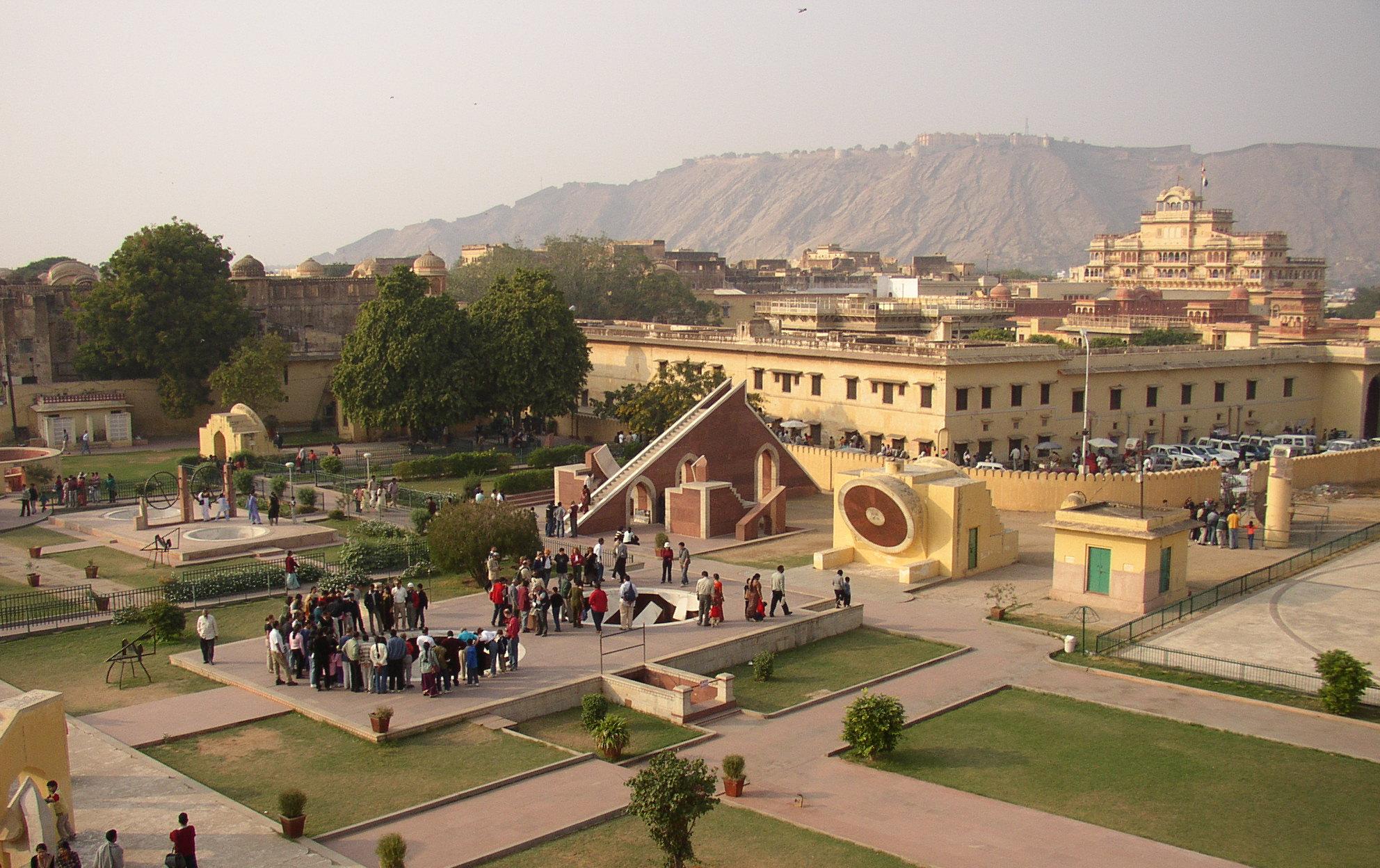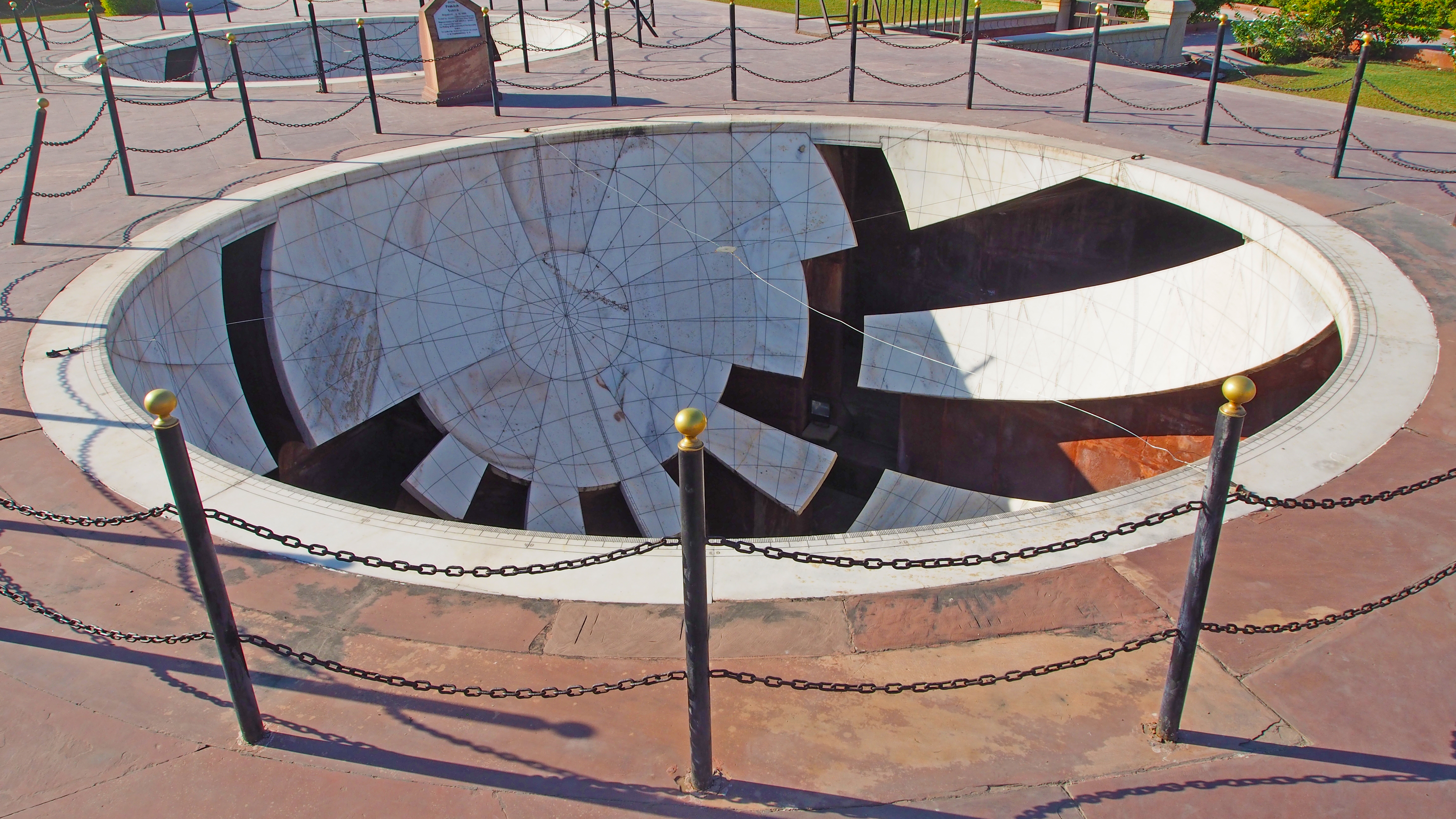Jantar Mantar on:
[Wikipedia]
[Google]
[Amazon]



 A Jantar Mantar ( Hindustani pronunciation: ͡ʒən̪t̪ər mən̪t̪ər is an assembly of stone-built astronomical instruments, designed to be used with the naked eye. There were five Jantar Mantars in
A Jantar Mantar ( Hindustani pronunciation: ͡ʒən̪t̪ər mən̪t̪ər is an assembly of stone-built astronomical instruments, designed to be used with the naked eye. There were five Jantar Mantars in
Jantar Mantar - The Astronomical Observatories of Jai Singh II
"a project initiated by Cornell University Professor of Art, Barry Perlus"
Jantar Mantar Jaipur Timings, Entry Fee
India's mysterious gateway to the stars
BBC Travel (2022-05-31) {{Coord, 26, 55, 28, N, 75, 49, 29.5, E, source:dewiki_region:IN, display=title Ancient astronomical observatories Archaeoastronomy Astronomical observatories in India Buildings and structures in Delhi History of science and technology in India Rajput architecture


 A Jantar Mantar ( Hindustani pronunciation: ͡ʒən̪t̪ər mən̪t̪ər is an assembly of stone-built astronomical instruments, designed to be used with the naked eye. There were five Jantar Mantars in
A Jantar Mantar ( Hindustani pronunciation: ͡ʒən̪t̪ər mən̪t̪ər is an assembly of stone-built astronomical instruments, designed to be used with the naked eye. There were five Jantar Mantars in India
India, officially the Republic of India, is a country in South Asia. It is the List of countries and dependencies by area, seventh-largest country by area; the List of countries by population (United Nations), most populous country since ...
. All were built at the command of the Rajah
Raja (; from , IAST ') is a noble or royal Sanskrit title historically used by some Indian rulers and monarchs and highest-ranking nobles. The title was historically used in the Indian subcontinent and Southeast Asia.
The title has a long ...
Jai Singh II
Sawai Jai Singh II (3 November 1688 – 21 September 1743), was the 30th Kachwaha Rajput ruler of the Kingdom of Amber, who later founded the fortified city of Jaipur and made it his capital. He became the ruler of Amber at the age of 11, after ...
, who had a keen interest in mathematics, architecture and astronomy. The largest example is the equinoctial sundial
A sundial is a horology, horological device that tells the time of day (referred to as civil time in modern usage) when direct sunlight shines by the position of the Sun, apparent position of the Sun in the sky. In the narrowest sense of the ...
belonging to Jaipur
Jaipur (; , ) is the List of state and union territory capitals in India, capital and the List of cities and towns in Rajasthan, largest city of the north-western States and union territories of India, Indian state of Rajasthan. , the city had ...
's assembly of instruments, consisting of a gigantic triangular gnomon
A gnomon (; ) is the part of a sundial that casts a shadow. The term is used for a variety of purposes in mathematics and other fields, typically to measure directions, position, or time.
History
A painted stick dating from 2300 BC that was ...
with the hypotenuse
In geometry, a hypotenuse is the side of a right triangle opposite to the right angle. It is the longest side of any such triangle; the two other shorter sides of such a triangle are called '' catheti'' or ''legs''. Every rectangle can be divided ...
parallel to the Earth
Earth is the third planet from the Sun and the only astronomical object known to Planetary habitability, harbor life. This is enabled by Earth being an ocean world, the only one in the Solar System sustaining liquid surface water. Almost all ...
's axis. On either side of the gnomon is a quadrant of a circle, parallel to the plane of the equator
The equator is the circle of latitude that divides Earth into the Northern Hemisphere, Northern and Southern Hemisphere, Southern Hemispheres of Earth, hemispheres. It is an imaginary line located at 0 degrees latitude, about in circumferen ...
. The instrument can be used with an accuracy of about 20 seconds by a skilled observer to determine the time of day, and the declination
In astronomy, declination (abbreviated dec; symbol ''δ'') is one of the two angles that locate a point on the celestial sphere in the equatorial coordinate system, the other being hour angle. The declination angle is measured north (positive) or ...
of the Sun
The Sun is the star at the centre of the Solar System. It is a massive, nearly perfect sphere of hot plasma, heated to incandescence by nuclear fusion reactions in its core, radiating the energy from its surface mainly as visible light a ...
and the other heavenly bodies. It is the world's largest stone sundial, and is known as the Samrat Yantra.
The Jaipur Jantar Mantar is a UNESCO World Heritage Site
World Heritage Sites are landmarks and areas with legal protection under an treaty, international treaty administered by UNESCO for having cultural, historical, or scientific significance. The sites are judged to contain "cultural and natural ...
.
History
In the early 18th century,Maharaja
Maharaja (also spelled Maharajah or Maharaj; ; feminine: Maharani) is a royal title in Indian subcontinent, Indian subcontinent of Sanskrit origin. In modern India and Medieval India, medieval northern India, the title was equivalent to a pri ...
Jai Singh II
Sawai Jai Singh II (3 November 1688 – 21 September 1743), was the 30th Kachwaha Rajput ruler of the Kingdom of Amber, who later founded the fortified city of Jaipur and made it his capital. He became the ruler of Amber at the age of 11, after ...
of Jaipur
Jaipur (; , ) is the List of state and union territory capitals in India, capital and the List of cities and towns in Rajasthan, largest city of the north-western States and union territories of India, Indian state of Rajasthan. , the city had ...
constructed five Jantar Mantar in total, in New Delhi
New Delhi (; ) is the Capital city, capital of India and a part of the Delhi, National Capital Territory of Delhi (NCT). New Delhi is the seat of all three branches of the Government of India, hosting the Rashtrapati Bhavan, New Parliament ...
, Jaipur
Jaipur (; , ) is the List of state and union territory capitals in India, capital and the List of cities and towns in Rajasthan, largest city of the north-western States and union territories of India, Indian state of Rajasthan. , the city had ...
, Ujjain
Ujjain (, , old name Avantika, ) or Ujjayinī is a city in Ujjain district of the Indian state of Madhya Pradesh. It is the fifth-largest city in Madhya Pradesh by population and is the administrative as well as religious centre of Ujjain ...
, Mathura
Mathura () is a city and the administrative headquarters of Mathura district in the states and union territories of India, Indian state of Uttar Pradesh. It is located south-east of Delhi; and about from the town of Vrindavan. In ancient ti ...
and Varanasi
Varanasi (, also Benares, Banaras ) or Kashi, is a city on the Ganges river in northern India that has a central place in the traditions of pilgrimage, death, and mourning in the Hindu world.*
*
*
* The city has a syncretic tradition of I ...
; they were completed between 1724 and 1735. Of these, the observatory at Mathura and the fort that protected it were destroyed before 1857.
As part of Jantar Mantar there were many instruments like Samrat Yantra, Jai Prakash Yantra, Disha Yantra, Rama Yantra, Chakra Yantra, Rashiwalya Yantra, Dingash Yantra and Utaansh Yantra. The primary purpose of the instruments was to compile astronomical tables and to predict the times and movements of the sun
The Sun is the star at the centre of the Solar System. It is a massive, nearly perfect sphere of hot plasma, heated to incandescence by nuclear fusion reactions in its core, radiating the energy from its surface mainly as visible light a ...
, moon
The Moon is Earth's only natural satellite. It Orbit of the Moon, orbits around Earth at Lunar distance, an average distance of (; about 30 times Earth diameter, Earth's diameter). The Moon rotation, rotates, with a rotation period (lunar ...
and planets
A planet is a large, rounded astronomical body that is generally required to be in orbit around a star, stellar remnant, or brown dwarf, and is not one itself. The Solar System has eight planets by the most restrictive definition of the te ...
.
Name
The name "Jantar Mantar" is at least 200 years old, being mentioned in an account from 1803. However, the archives of Jaipur State, such as accounts from 1735 and 1737–1738, do not use this as ''Jantra'', which in the spoken language is corrupted to ''Jantar''. The word ''Jantra'' is derived from ''yantra
Yantra (; 'machine'/'contraption') is a geometrical diagram, mainly from the Tantric traditions of the Indian religions. Yantras are used for the worship of deities in temples or at home; as an aid in meditation; and for the benefits believe ...
'', instrument, while the suffix ''Mantar'' is derived from mantrana meaning consult or calculate.
See also
* Jantar Mantar in Jaipur * Jantar Mantar in New Delhi * Jantar Mantar in Varanasi * Jantar Mantar in Ujjain *List of archaeoastronomical sites sorted by country
This is a list of sites where claims for the use of archaeoastronomy have been made, sorted by country.
The International Council on Monuments and Sites (ICOMOS) and the International Astronomical Union (IAU) jointly published a thematic study on ...
*List of astronomical observatories
This is a partial list of astronomical observatories ordered by name, along with initial dates of operation (where an accurate date is available) and location. The list also includes a final year of operation for many observatories that are no lon ...
*Yantra
Yantra (; 'machine'/'contraption') is a geometrical diagram, mainly from the Tantric traditions of the Indian religions. Yantras are used for the worship of deities in temples or at home; as an aid in meditation; and for the benefits believe ...
*Mantra
A mantra ( ; Pali: ''mantra'') or mantram (Devanagari: मन्त्रम्) is a sacred utterance, a numinous sound, a syllable, word or phonemes, or group of words (most often in an Indo-Iranian language like Sanskrit or Avestan) belie ...
References
*External links
Jantar Mantar - The Astronomical Observatories of Jai Singh II
"a project initiated by Cornell University Professor of Art, Barry Perlus"
Jantar Mantar Jaipur Timings, Entry Fee
India's mysterious gateway to the stars
BBC Travel (2022-05-31) {{Coord, 26, 55, 28, N, 75, 49, 29.5, E, source:dewiki_region:IN, display=title Ancient astronomical observatories Archaeoastronomy Astronomical observatories in India Buildings and structures in Delhi History of science and technology in India Rajput architecture